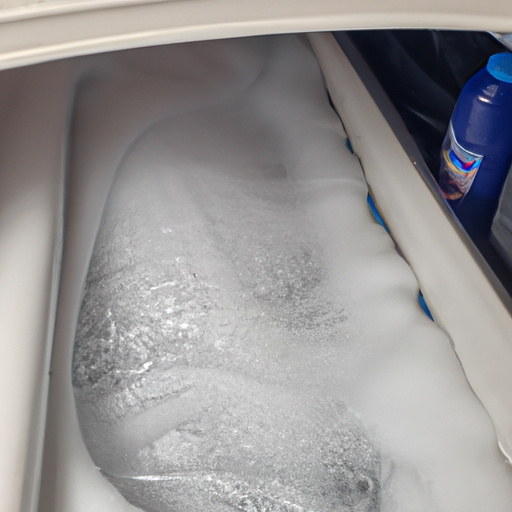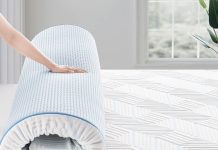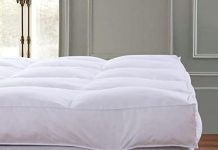Cleaning mattress protectors is an essential part of maintaining a clean and hygienic sleeping environment. But with so many options available, it’s easy to get confused about the correct way to clean them. In this article, we will guide you through the step-by-step process of effectively cleaning mattress protectors, ensuring you can enjoy a fresh and comfortable night’s sleep, free from allergens and stains. Say goodbye to the worry of dirt and spills, as we reveal the secrets to keeping your mattress protector clean and pristine.
Review contents
How Do You Clean Mattress Protectors?
Cleaning mattress protectors is an essential part of maintaining a clean and healthy sleeping environment. Mattress protectors not only protect your mattress from spills, stains, and allergens but also need regular maintenance to ensure they continue to provide these benefits. In this comprehensive guide, we will walk you through the general cleaning instructions and provide specific cleaning tips for different types of mattress protectors. So, let’s dive in!
General Cleaning Instructions
Before we delve into the specific cleaning methods, there are a few general cleaning instructions that apply to all types of mattress protectors. Firstly, always refer to the care instructions provided by the manufacturer for the best cleaning practices. These instructions may vary depending on the material and construction of the mattress protector.
It is advisable to clean your mattress protector regularly. Aim to wash it at least once every two to three months, or more frequently if pets or children often share the bed. Regular washing helps remove dust mites, sweat, and other impurities that can accumulate on the surface.
When it comes to cleaning mattress protectors, it is crucial to follow the recommended washing and drying temperatures. Using excessively hot water or high heat can cause the protector’s fabric to shrink or lose its protective properties. Always check the care label and adjust your settings accordingly.
Preparing the Mattress Protector for Cleaning
Before you begin the cleaning process, it is essential to prepare the mattress protector properly. Start by stripping off all bedding, including sheets and pillowcases, from the mattress protector. Inspect the protector for any stains or spots that need special attention, as we will discuss later in this article.
Cleaning a Waterproof Mattress Protector
Waterproof mattress protectors are designed to repel liquids and prevent them from seeping through to the mattress. Cleaning a waterproof mattress protector requires a slightly different approach than other types.
Begin by spot-cleaning any visible stains using a mild detergent or stain remover. Gently rub the affected area with a soft cloth or sponge until the stain fades away. Avoid using harsh chemicals or abrasive cleaners, as they may damage the waterproof coating.
Once the stains are addressed, machine wash the mattress protector using a gentle cycle and cold or lukewarm water. Use a mild detergent that is free from bleach and fabric softeners. These additives can compromise the protector’s waterproof qualities and diminish its effectiveness.
After the wash cycle is complete, it is crucial to rinse the protector thoroughly to remove any leftover soap residue. Residual soap can cause skin irritation and affect the waterproof properties. Ensure the rinse cycle is set to cold or lukewarm water.
Cleaning a Breathable Mattress Protector
Breathable mattress protectors are designed to enhance air circulation and regulate temperature for a more comfortable sleep environment. Cleaning a breathable mattress protector follows a similar process to waterproof protectors, with a few minor differences.
To clean a breathable mattress protector, start by spot-treating any stains or spots with a mild detergent. Gently blot the stain using a clean cloth or sponge. Avoid scrubbing vigorously, as it may damage the protector’s breathable fabric.
Next, wash the mattress protector using a gentle cycle and cold or lukewarm water. Use a mild detergent without bleach or fabric softeners to protect the breathable qualities. Rinse the protector thoroughly in cold or lukewarm water to remove any soap residue.
Cleaning a Pillow-top Mattress Protector
Pillow-top mattress protectors feature an additional layer of padding on top for added comfort. Cleaning these protectors requires extra care to ensure the pillow-top remains intact.
To clean a pillow-top mattress protector, begin by spot-cleaning any stains using a mild detergent or stain remover. Gently dab the stain without rubbing too vigorously, as it may damage the delicate padding.
Next, follow the manufacturer’s instructions for the best cleaning method. Some pillow-top protectors may be machine washable, while others may require handwashing to preserve the padding. If machine washing is recommended, use a gentle cycle and cold or lukewarm water.
After cleaning, make sure to dry the pillow-top mattress protector thoroughly to prevent moisture buildup that can lead to mold or mildew growth. Air drying is the safest option, but if using a dryer, select a low heat setting to prevent damage to the delicate padding.
Removing Stains and Odors
Accidents happen, and stains or odors on mattress protectors are not uncommon. Fortunately, there are several methods you can use to tackle stubborn stains and unpleasant smells.
Using Household Cleaners
For general stains, consider using household cleaners such as hydrogen peroxide or ammonia. Start by diluting the cleaner according to the manufacturer’s instructions. Then, using a clean cloth or sponge, dab the stain gently with the diluted cleaner. Avoid rubbing vigorously, as it may spread the stain or damage the fabric. Rinse the area thoroughly with water and let it air dry.
Using Natural Cleaners
If you prefer natural cleaning methods, there are eco-friendly options available for stain and odor removal. Baking soda mixed with water into a paste can effectively remove stains and neutralize odors. Apply the paste to the affected area, let it sit for a few hours, then blot it away with a clean cloth or sponge. Rinse the protector with water and allow it to air dry.
Drying and Storing the Mattress Protector
Once the cleaning process is complete, it is essential to dry and store the mattress protector properly. After washing, gently wring out any excess water without twisting or squeezing the protector. Avoid using high heat settings in the dryer, as they can damage the fabric or shrink the protector. Instead, opt for a low heat or air fluff setting until the protector is completely dry.
Before storing the mattress protector, inspect it for any remaining stains or spots. Ensure the protector is entirely dry to prevent musty odors or mold growth in storage. Then, fold the protector neatly and store it in a clean, dry place away from direct sunlight or moisture.
Frequency of Cleaning
The frequency of cleaning your mattress protector depends on various factors, including personal preferences, allergies, and the amount of use it receives. It is generally recommended to wash the protector at least once every two to three months. However, if you or your family members suffer from allergies or asthma, more frequent cleaning may be necessary.
Remember, prevention is key to maintaining a clean mattress protector. Regularly vacuuming the protector’s surface and addressing spills or stains promptly can help prolong its lifespan and keep it in pristine condition.
In conclusion, cleaning mattress protectors is a necessary task for maintaining a clean and hygienic sleeping environment. By following the general cleaning instructions and the specific cleaning methods for different types of protectors, you can ensure that your mattress protector remains fresh, stain-free, and prolong its lifespan. So, take the time to care for your mattress protector, and it will continue to protect your mattress and provide you with a comfortable and healthy sleep experience.
























